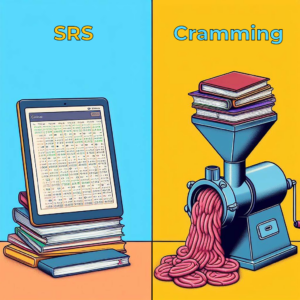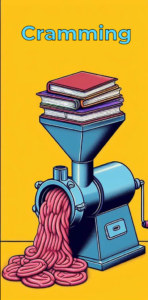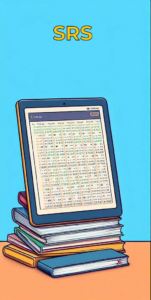
Reviewing is an integral part of learning Chinese, and students who don’t do it will forget most of what they have learned. Most students know that reviewing is important, but when it comes to how to review, things become hazier.
Simply looking at or rereading already familiar content is common but very inefficient, especially when it comes to learning to write characters. That requires you to actively probe your memory through active recall; simply reading is not enough.
Tune in to the Hacking Chinese Podcast to listen to the related episode (#241):
Available on Apple Podcasts, Spotify, YouTube and many other platforms!
Extensive reading and listening is the best form of review
Other ways to review include extensive reading and listening to new content that largely uses the same characters, words, and expressions. Graded readers and podcasts at lower levels than your own are particularly useful for this.
There are many reasons why extensive reading and listening are awesome, but the main one is that you encounter the same words over and over in slightly different contexts, allowing you to form form-meaning connections. This is vastly superior to seeing the words used in the same sentences over and over, such as when reviewing a textbook.
For recommendations, see:
- The 10 best free Chinese reading resources for beginner, intermediate and advanced learners
- The 10 best free Chinese listening resources for beginner, intermediate and advanced learners
The 10 best free Chinese reading resources for beginner, intermediate and advanced learners
For a discussion of the benefits of reviewing through reading rather than a flashcard program, see Reading is a lot like spaced repetition, only better.
When and how should you review Chinese vocabulary?
As noted, if you want to learn Chinese characters, especially handwriting, simply reading won’t be enough. There are also other situations where you might want to invest time specifically into learning and reviewing vocabulary.
In this article, we’re going to look at one specific aspect of how to review: the timing. Put briefly, how should the reviews be distributed over time? Should reviews be massed together (cramming) or spread out (spaced repetition)?
Understanding cramming vs. spaced repetition
Reviews of a specific item, such as a Chinese character or word, can either be crammed together in a short period (sometimes called massed repetition in the literature) or spread out over time (usually called spaced repetition or distributed repetition).
Cramming is common when preparing for exams in school, including for students of Chinese at university.
Spaced repetition is not as common, unless built into apps that some people use to learn Chinese, such as Anki, Pleco or Skritter. It’s a pity that spaced repetition isn’t used more because it has been shown repeatedly to be much more efficient, even though people who use it may perceive it not to be (see, for example, Zechmeister & Shaughnessy, 1980; Bahrick, 1993); more about this later.
Spaced repetition is often associated with flashcards, because flashcards offer a convenient way to spread reviews out over time. I’ve discussed the pros and cons of using flashcards in a series of articles with a summary here: How to best use flashcards to learn Chinese.
What to do if you’re new to spaced repetition
This article is not meant to explain what spaced repetition is and how it works, so if you’re new to the idea, please read my old article about spaced repetition software for Chinese students. In short, using a program to spread reviews out over time according to a certain algorithm can vastly improve your recall of vocabulary items.
 Why cramming remains popular: there’s more to cramming than you might think
Why cramming remains popular: there’s more to cramming than you might think
One might think that if spaced repetition works so well, students would gradually adopt it as a superior method.
This is not the case, though. Research even shows the opposite, namely that cramming becomes more widespread the longer students have studied (see Vacha & McBride, 1993).
If cramming is worse than spaced repetition, how come students gravitate towards cramming anyway?
There are many factors influencing what methods students use to pass exams, but here are some plausible ones why they choose cramming over spaced repetition:
- Cramming actually works in the short term. Few would argue that spaced repetition is very effective for preparing for exams the next week, because there needs to be enough time to space the reviews. Even programmes built on the idea of spaced repetition, such as Anki, have cram modes. This is not only because users want it (which I’m sure they do), but because it might be the best method for short-term learning.
- Institutional learning is often short-sighted. In language courses, exams often focus on new material, with older material only being tested incidentally. Thus, a strategy based on cramming for exams usually does work, especially if you don’t expect to be tested on last week’s characters this week and there is no final exam with all the characters.
- Sometimes the goal is short-term. If you have a basic proficiency already but want to use your Mandarin for something specific, cramming will lead to quicker results. For example, if you have a business meeting focusing on a type of product you’re not used to, cramming might be the best option. You might not need all that vocabulary in the long term, but you do need it for that meeting. The same could be true for educational purposes, translation, interpreting and many other situations where long-term learning is not the goal.
- Students might lack the discipline to use spaced repetition. Even if students believe spaced repetition is the best way to learn (and many don’t; see below), they might still be too lazy or undisciplined to use it. Everybody knows that doing something when you have to, such as cramming for an exam the next day, is easier than preparing a little bit every day for something months away. I’ve known about the benefits of spaced repetition for a long time but have still crammed occasionally for exams.
- Students underestimate the effectiveness of spaced repetition. This remains true even after they have tried it and performed better than they would have otherwise. In a study by Kornell (2009), it was found that students who used spaced repetition did better than students who used massed repetition. But even after sitting an exam and having their knowledge tested, they still believed that massing was more efficient!
Why students underestimate spaced repetition
The reason they are mistaken could be related to several things.
For instance, they might mistake ease of repetition for actual recall. Looking at something you already know feels familiar, so you might fool yourself into believing you remembered it better than an exam would show. This is similar to rereading a book to prepare for an exam, which makes you feel like you’re studying, but which is actually next to useless (see Callender & McDaniel, 2009).
It could also be that spreading reviews out over time feels less effective because you can’t mentally check a box and say you’re now done with section 15b after 30 minutes of cramming it.
Spaced repetition is superior because learning Chinese is not a short-term project
To summarise, cramming is a valid method that works for short-term studying. If you want to pass a course focusing on limited content and grades is everything you care about, cramming does the trick. For more about how to study to get good grades, check How to get good grades when studying Chinese.
However, learning Chinese is not a short-term project. It takes years.
You still need to know all the things you learn as a beginner as an intermediate student, and most of the things you learn as an intermediate student, you will need at an advanced level.
You don’t only need to know them, but you need to know them fast!
When to use cramming vs. spaced repetition
So, cramming mostly works because of the way institutional language learning is structured. If all students learnt Chinese with long-term goals of being able to communicate well in the language, cramming would almost never be the right choice. The real world of communication in a language is long term.
Using spaced repetition for successful long-term learning
As learners of Chinese, we need spaced repetition to commit characters, words, and expressions to long-term memory in an efficient way.
Note that efficiency is important here because the same study I quoted above that said that cramming worked also said cramming took more hours.
We don’t want that. We want to use those hours to immerse ourselves in the language more or perhaps learn even more vocabulary.
What teachers can do to avoid their students cramming
As teachers of Chinese, we need to stop organising our teaching in a way that promotes cramming. Or, put differently, we need to structure our courses so that the methods that promote long-term success also work in our classrooms. The goal is for our students to learn Chinese, after all, not to get a grade.
Courses and lessons should be designed with the long-term benefit of students in mind, and cramming does not promote that. Assessment should be continuous and not only focus on what has been taught recently. Exams should focus on students’ ability to communicate, not how well they’ve memorised the five most recent chapters in their textbook.
Students should, of course, be told about this in advance, and they should be given the tools to cope. Spaced repetition is one of them.
References and further reading
Bahrick, H. P., Bahrick, L. E., Bahrick, A. S., & Bahrick, P. E. (1993). Maintenance of foreign language vocabulary and the spacing effect. Psychological Science, 4(5), 316-321.
Bloom, K. C., & Shuell, T. J. (1981). Effects of massed and distributed practice on the learning and retention of second-language vocabulary. The Journal of Educational Research, 74(4), 245-248.
Callender, A., & McDaniel, M. (2009). The Limited Benefits of Rereading Educational Texts.. Contemporary Educational Psychology, 34, 30-41.
Kornell, N., & Bjork, R. A. (2008). Learning concepts and categories: Is spacing the “enemy of induction”?. Psychological science, 19(6), 585-592.
Kornell, N. (2009). Optimising learning using flashcards: Spacing is more effective than cramming. Applied Cognitive Psychology: The Official Journal of the Society for Applied Research in Memory and Cognition, 23(9), 1297-1317.
Vacha, E. F., & McBride, M. J. (1993). Cramming: A barrier to student success, a way to beat the system or an effective learning strategy?. College Student Journal.
Zechmeister, E. B., & Shaughnessy, J. J. (1980). When you know that you know and when you think that you know but you don’t. Bulletin of the Psychonomic Society, 15(1), 41-44.


6 comments
Was interesting to read, would love if you could proofread and fix up the typos (got in the way of comprehension in some places).
Always been a fan of spaced repetition, even before I knew it was a thing I was doing it. I’m surprised people think it’s not effective even after trying it.
Thanks for pointing this out! I have fixed the errors and updated the article.
I have also used spaced repetition since the very beginning because it just made sense to me. I was a bit stupid and actually developed my own system without really checking the available tools and research. I ended up with big spreadsheets telling me when to study what (in smaller chunks), which worked okay until I found Anki.
Hi Olle, I’m heading for China in a month. While I use Anki for space repetition all the time, I do feel the need for some cramming of key words and phrases before seeing the inlaws again (!). Soooo, my question is, how best to cram? I have scraps of paper with word and phrase lists, plus lists on my phone and iPad. How do you go about cramming?
Another cramming scenario: short-term notice for a meeting on a specialized topic (or any specialized event coming up). See here: http://countryoftheblind.blogspot.com/2013/07/a-cramming-case-study.html
Yes, good point. Any time where short-term retention is the most important thing. I mean, even if you use SRS normally, if you care about the grades enough, cramming will probably add a few points if done addition to SRS too.
Hi Olle
I’ve been learning Mandadrin for a few years now and have lived in China for just over a year. I’m at the lower intermediate level.
I spend quite a long time using flash cards, probably more than I need to but actually I prefer it this way because it I can really take the time to study the characters that I haven’t learnt succiently – in detail by looking at the composition of the characters and plenty of example sentences. Doing this, I find that I can recall characters better than when I first started using it. Back then I’d go through it quicker but I wasn’ satisfied with my long-term recall ability.
Was there ever a time when you had to spend a longer amount time on spaced repition flash cards to remember characters?
Also, I very very rarely finish a set of flash cards in a day so I can’t even compare the amount of time I spend to you but I can say it’s over 40mins, probably just over an hr every day.
BTW, I’ve followed HC on and off for a few years and I love the work your doing. Best of all you have greatly influenced the way I study so thank you.